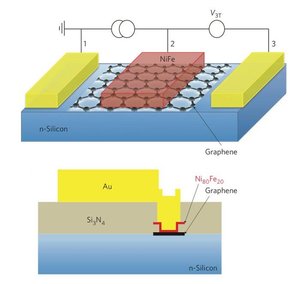Researchers create new microparticles that self-assemble like atoms into molecules
Updated: 2012-10-31 21:01:57
Scientists have created new kinds of particles, 1/100th the diameter of a human hair, that spontaneously assemble themselves into structures resembling molecules made from atoms. These new particles come together, or "self-assemble," to form structures in patterns that were previously impossible to make and hold promise for manufacturing advanced optical materials and ceramics.

 Cholesteric liquid crystals (CLCs) show selective reflection due to their helical structures. They are formed by the introduction of chiral elements into liquid crystals molecules or by doping of nematic liquid crystals with chiral dopants. Photoresponsive chiral dopants are increasing being used to fabricate tuneable CLCs.
In this hot paper, Liu and colleagues use an imprinting [...]
Cholesteric liquid crystals (CLCs) show selective reflection due to their helical structures. They are formed by the introduction of chiral elements into liquid crystals molecules or by doping of nematic liquid crystals with chiral dopants. Photoresponsive chiral dopants are increasing being used to fabricate tuneable CLCs.
In this hot paper, Liu and colleagues use an imprinting [...] Fabrication of ZnO nanodisc arrays is reported using nanoimprint lithography (NIL) mold obtained sub-100 nm pattern resolution by Srinivasan, Krishnamoorthy and co-workers.
ZnO nanostructures have many applications such as use in LEDs, gas sensors and semiconducting devices. Controlling the densities, geometric attributes and batch to batch reproducibility of nanostructured ZnO can be a challenge. In this [...]
Fabrication of ZnO nanodisc arrays is reported using nanoimprint lithography (NIL) mold obtained sub-100 nm pattern resolution by Srinivasan, Krishnamoorthy and co-workers.
ZnO nanostructures have many applications such as use in LEDs, gas sensors and semiconducting devices. Controlling the densities, geometric attributes and batch to batch reproducibility of nanostructured ZnO can be a challenge. In this [...] A thin film nanocomposite dielectric that can be prepared by deposition of Bi-doped BaTiO3 nanocrystals on to a polymer is reported by O’Brien and colleagues.
In this hot paper, the authors use a novel approach to synthesise bismuth acceptor doped nanocrystals, Ba(TixBi1-x)O3. The nanocrystals can be synthesised at low temperatures via a solvothermal method and are [...]
A thin film nanocomposite dielectric that can be prepared by deposition of Bi-doped BaTiO3 nanocrystals on to a polymer is reported by O’Brien and colleagues.
In this hot paper, the authors use a novel approach to synthesise bismuth acceptor doped nanocrystals, Ba(TixBi1-x)O3. The nanocrystals can be synthesised at low temperatures via a solvothermal method and are [...] Home Introduction The source of ferromagnetism in dilute magnetic semiconductors finally explained Tweet Technical Researchers developed a new technique called HARPES Hard x-ray Angle-Resolved PhotoEmission Spectroscopy that can be used to investigate the bulk electronic structure of different materials . In the first application , they checked the bulk electronic structure of the prototypical dilute magnetic semiconductor gallium manganese arsenide , and discovered that the material’s ferromagnetism arises from both of the two different mechanisms that have been proposed to explain it . Understanding the source of ferromagnetism in dilute magnetic semiconductors is an important milestone toward using these materials in Spintronics . devices HARPES , which is based on the photoelectric
Home Introduction The source of ferromagnetism in dilute magnetic semiconductors finally explained Tweet Technical Researchers developed a new technique called HARPES Hard x-ray Angle-Resolved PhotoEmission Spectroscopy that can be used to investigate the bulk electronic structure of different materials . In the first application , they checked the bulk electronic structure of the prototypical dilute magnetic semiconductor gallium manganese arsenide , and discovered that the material’s ferromagnetism arises from both of the two different mechanisms that have been proposed to explain it . Understanding the source of ferromagnetism in dilute magnetic semiconductors is an important milestone toward using these materials in Spintronics . devices HARPES , which is based on the photoelectric Did you know that Advance Articles for our new family of Journal of Materials Chemistry journals have been published. Click on the covers below to view the Advance Articles:
Follow the latest journal news on Twitter @JMaterChem or go to our Facebook page.
To keep up-to-date with all the latest research, sign-up to our RSS feed [...]
Did you know that Advance Articles for our new family of Journal of Materials Chemistry journals have been published. Click on the covers below to view the Advance Articles:
Follow the latest journal news on Twitter @JMaterChem or go to our Facebook page.
To keep up-to-date with all the latest research, sign-up to our RSS feed [...] Home Introduction Graphene proves to be an excellent tunnel barrier Tweet Technical Researchers from the US Naval Research Laboratory NRL discovered a way to use graphene as an extremely thin tunnel barrier to conduction . This could be very useful for Spintronics devices . The researchers have shown that graphene can serve as an excellent tunnel barrier when current is directed perpendicular to the plane of carbon atoms . The spin polarization of the current is also preserved by the tunnel . barrier The researchers replaced the normally used oxide barriers which introduce defects into the system and feature too high a resistance with graphene which is defect resistant and chemically inert and . stable Via : Graphene-Info Oct 09, 2012 Login register to post comments Tweet Similar entries
Home Introduction Graphene proves to be an excellent tunnel barrier Tweet Technical Researchers from the US Naval Research Laboratory NRL discovered a way to use graphene as an extremely thin tunnel barrier to conduction . This could be very useful for Spintronics devices . The researchers have shown that graphene can serve as an excellent tunnel barrier when current is directed perpendicular to the plane of carbon atoms . The spin polarization of the current is also preserved by the tunnel . barrier The researchers replaced the normally used oxide barriers which introduce defects into the system and feature too high a resistance with graphene which is defect resistant and chemically inert and . stable Via : Graphene-Info Oct 09, 2012 Login register to post comments Tweet Similar entries Closing date for submission of abstracts is 9th November!
Closing date for submission of abstracts is 9th November!